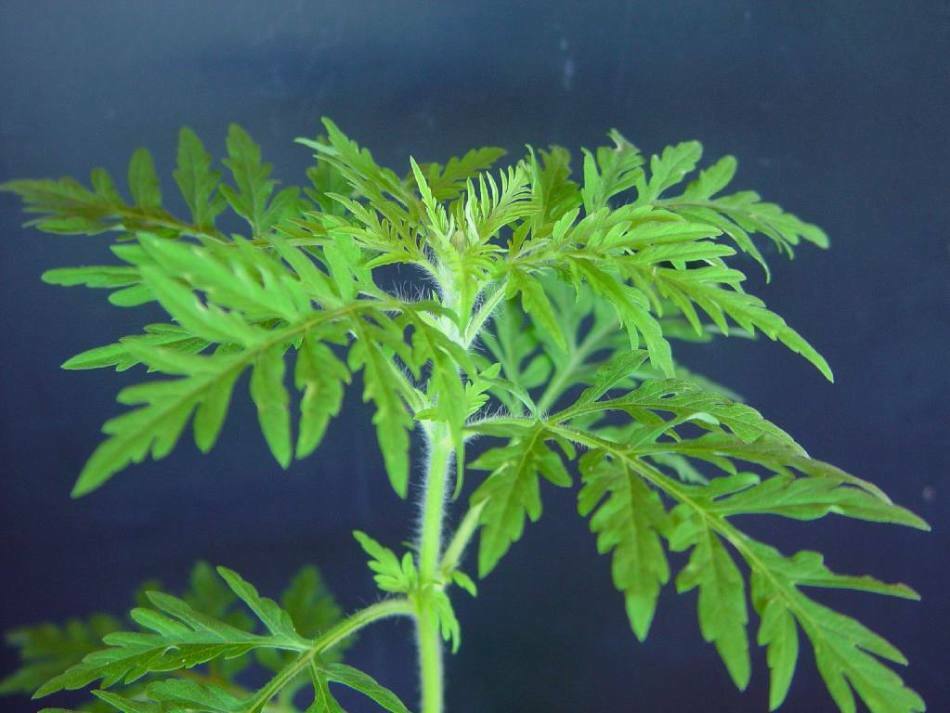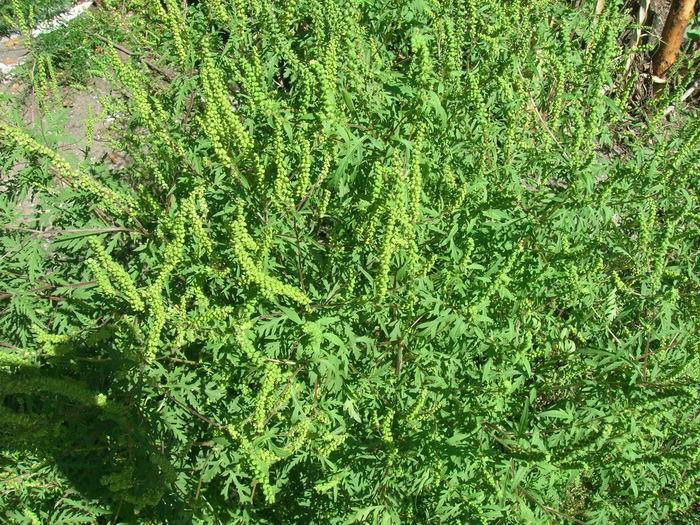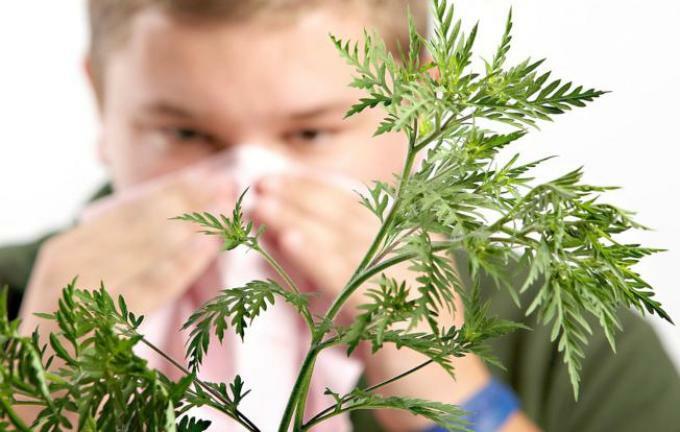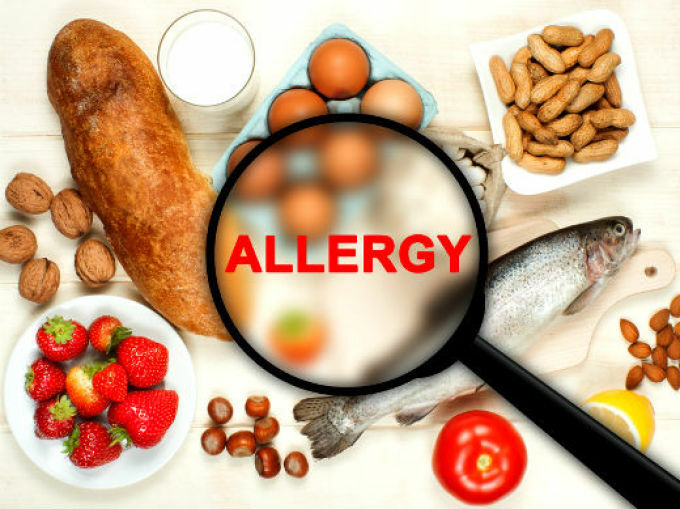The article will tell you how to survive the allergy to the most powerful allergen - ambrosia.
Contents
- Plant ambrosia - how does it look, where it grows when it blooms?
- Seasonal allergy to ragweed: symptoms, signs in adults and children
- When does the allergy to ragweed start and end?
- Ambrosia treatment: what to drink when you are allergic to ragweed?
- Modern preparations for allergies to ragweed: injections, tablets: which is better, more effective?
- What are the drops in the nose, the eyes are best for allergies to ragweed?
- The new generation of allergies to ragweed
- Folk remedies for allergy to ragweed
- Than to treat allergy to ragweed in children?
- Than to treat an allergy to ambrosia at pregnancy and thoracal feeding?
- What should not be eaten with ragweed allergies: the
- diet Ambrosia allergy temperature: what to do?
- How to relieve symptoms and condition with ragweed allergy?
- How to get rid of allergy to ragweed forever?
- When ragweed blooms in the Krasnodar Territory, the Crimea, Sochi, Anapa, Cyprus?
- Video: "Allergy to ragweed: what to do?"
Ambrosia plant - how does it look where it grows when it blooms?
This plant, like ambrosia, is known and seen by everyone, since it has a habit to grow, both in rural areas and in urban areas. The thing is that ragweed is a weed. A feature of the grass is that it can be annual and perennial. The stem is straight and its height can reach up to two meters.
INTERESTING: For the first time ambrosia was seen in North America and it is believed that the seeds of this plant were accidentally brought to Europe along with clover seeds in the 18-19th century. In North America there are about 40 varieties of ragweed, in our region there are only three. Polynolist ragweed is also used in medicine. Homeopathic preparations are prepared from it.
Ambrosia is a strong allergen, moreover, the pollen of this herb is considered a "quarantine" allergen. The ragweed system is very strong. Some roots can go deep down to 4 meters. The leaves of ambrosia are long and dissected, up to 13-15 centimeters long. The leaves have a green tint on the upper side and a silver one on the lower side.
IMPORTANT: Ambrosia has several subspecies and, depending on them, blooms in a certain period of time in the warm season. In general, the flowering period begins in July and ends in October.
Where ambrosia is most common:
- Ukraine ( here the global spread of the plant got after the Great Patriotic War due to a large number of moving vehicles).
- Caucasus ( northern part)
- Russia ( south and southeast regions)
- Primorye
- Volga region
INTERESTING: ragweed has one very unpleasant feature, like a plant, its deep roots take absolutely all nutrients and nutrients from the soil. After such exhaustion, the soil becomes completely barren and incapable of growing crops.
 Ambrosia leaf
Ambrosia leaf  Adult plant
Adult plant Seasonal allergy to ragweed: symptoms, signs in adults and children
Ambrosia is a strong seasonal allergen. In a person who is not predisposed to allergies and is not very sensitive, it can cause mild symptoms. In allergic people, people with weak immunity and a frustrated hormonal background, the allergy becomes unbearable and requires intervention.
IMPORTANT: The person is sensitive to ragweed pollen. In most cases, the first symptom of allergy is rhinitis( stuffy nose).In some cases, pollen shows or exacerbates asthma. Symptoms of allergy to ragweed in adults:
- Rhinitis ( mild or severe obstruction of mucus and air in the nasal sinuses).
- Itching in the nasal sinuses, in the nasopharynx, in the sky, in the tongue, in the oral cavity.
- Sore throat ( ranging from discomfort and ending with pain, compare angina).
- Cough ( after choking or severe itching of the sky)
- Conjunctivitis ( subsequently pollen entering the eye or rhinitis, due to obstruction of the nasal sinuses and a blocked, inflamed tear duct).
- Hives ( itching, redness of different strengths in different parts of the body).
- Quincke edema
Symptoms of ragweed allergy in children:
- Stuffy nose
- Snot
- Sneezing
- Dry cough
- Urticaria
- Tears
- Itching on mucous
 Symptoms of allergy
Symptoms of allergy When does the allergy to ambrosia start and end?
As already mentioned, the period of ragweed blossoming begins in July and at the same time people have the first symptoms of allergy-rhinitis, snot and itch in the nasal sinuses. As the flowering plants blossom, the allergy may increase.
The more ragweed grows in the area in which you live, the stronger the allergy may be( for example, in rural areas it is stronger than in the city).The peak of the allergy is in August and September and the person begins to feel a decline in October.
IMPORTANT: The allergy goes away very slowly, at first itching and urticaria can go away, then the stuffiness of the nose and sneezing, until the full recovery.
Ambrosia treatment: what to drink when you are allergic to ragweed?
Any allergy can be either curable or treatable( i.e., for some time you can eliminate symptoms).The best treatment is to leave the place of residence, which has a large amount of allergen( ie, move on for a while).But, it is practically impossible to do this to a modern person( work, lack of money, temporary housing, etc.).
The most effective means that a person can make for himself to prevent the development of an allergy is timely vaccination. That is, the body introduces a minimum amount of an allergen and it produces immunity to it. This is done far before the ragwalking period.
However, not everyone agrees to vaccination, because from such therapy one can expect any results, both improvement of one's condition and deterioration. That is why the most popular drugs for allergies to ambrosia are antihistamines( anti-allergy drugs).Such remedies improve health by increasing immunity, normalizing the hormonal background and partial withdrawal of the allergen from the body.
What can I take:
- Suprastin
- Diazolin
- Edem
- Allerone
- Cetrin
IMPORTANT: The list of medications is large enough and varies, depending on the pharmacy and the country. It is important to take the remedy correctly, observing the regimen and not exceeding the dosage. If you notice that the selected drug has stopped functioning, temporarily replace it with another name.
Modern remedies for allergies to ragweed: injections, tablets: which is better, more effective?
The allergy starts to develop even when a small piece of pollen gets on the nasal mucosa or throat through the breath. A strong allergy can be eliminated by taking a number of antiallergenic drugs. In the case when a person has very weak immunity or hormonal failure( transferred illness, childbirth, abortion, pregnancy), doctors can recommend vaccination.
For example, an injection called "Diprospan"( there are other names of medicines).The drug is administered intramuscularly, it can be administered to both adults and children. Before entering the medication, you should consult your doctor. The dosage of the drug is also regulated by the doctor. You should study your features before you enter the medication, as it has contraindications: gastritis, ulcers, kidney and liver diseases.
IMPORTANT: The injection works much faster and stronger than the tablet. The first relief a person can feel after two or three hours( the nasal sinuses do not swell and the itching slowly goes away).
What are the drops in the nose, the ophthalmic best for allergies to ragweed?
As already mentioned, rhinitis in allergic reaction to ambrosia occurs in most people sensitive to pollen. Together with rhinitis, inflammation of the tear duct can occur. If there is inflammation and obstruction of tears, a person acquires conjunctivitis.
IMPORTANT: Eye drops and drops in the nose will help cope with the clogged nose and sore eyes.
Eye drops:
- The mediator - removes the inflammation of the eye and makes the allergy softer.
- Ketotifen - removes allergic inflammation
- Patanol - eliminates allergic inflammation, itching, redness
- Optivar -
Nasal drops:
- Baconase - eliminates allergic reaction, eliminates inflammation of the nasal sinuses.
- NAZONEX is a concentrated remedy for the control of allergic rhinitis.
- Aqua - Maris - moisturizes and soothes the nasal mucosa
- Eucazoline - pierces the nose, eliminates the inflammation of the nasal sinuses.
Preparations of the new generation from the allergy to ragweed
Preparations of the new generation are called hormonal agents. They are also not rarely called "third generation" drugs. They act on the body, changing the hormonal background.
IMPORTANT: The action of the hormone preparation is very simple - it does not allow the immune cells of the body to release active substances. In consequence, the body is stronger and confronts all unpleasant allergic symptoms, preventing them from any recurrence.
The most popular drugs for internal use:
- Desloratadine - effectively fights against year-round allergy
- Levocetirizine - does not give allergies, it weakens the course of allergies.
- Telfast - weakens allergic symptoms, eliminates rhinitis and hives.
IMPORTANT: Hormonal preparations for allergy can be, as tablets, and injections, as well as nasal drops.
Folk remedies for allergy to ambrosia
Traditional medicine has established itself as a faithful "helper" and friend of man in getting rid of many diseases. If it is an allergy, then it acts as a remedy that can weaken strong, manifested symptoms. In addition, recipes for traditional medicine in the treatment of ragweed allergy should be taken in conjunction with drug treatment and only when you do not have sensitivity to certain herbal preparations.
What can be used in the treatment of ragweed allergy:
- Celery - green part. The ground beams can be mixed with honey and taken after infusion of several spoons a day. Celery removes toxins, including allergens from the blood.
- Nettle - leaves. Boiled broth from the leaves mixed with broth of wild rose and drunk up to 5 times a day with small spoons. It strengthens the immune system, thereby helping it to fight against allergens. To the same recipes can be attributed a pure broth of dogrose and broth with spruce needles.
- Calendula - flowers. Infusion of flowers( not a decoction, but simply filled with boiling water and infused flowers) helps to ease allergic symptoms. Drink half a glass twice a day.
- Diavesil - root. It should be boiled for at least 15 minutes and drink only tablespoons three times a day. Helps to eliminate unpleasant allergy symptoms or at least make them less powerful.
- The sequence is leaves. Effectively eliminate urticaria on the skin( it is recommended to take a bath with a decoction of leaves).
- Burdock - root. Boil and insist the roots should be up to 12 hours. Drink with sugar and milk. The remedy helps to fight the allergen that has got into the body, weakening its symptoms.
- Oak bark - a decoction or infusion perfectly fights with cutaneous manifestations of allergy. Recommended for external use.
- Peppermint - leaves. The broth helps to ease the symptoms and slightly stabilize the hormonal background, to calm and relax.
- Decoction or clover juice - is intended for external use as compresses, perfectly fights against tearing.
How to treat allergy to ragweed in children?
Unfortunately, every third child has an allergic predisposition. The reasons for this are not favorable modern ecology, poor quality of food, preservatives, as a result of which the immune system suffers and weakens. In summer, during the flowering period, the allergy may be more severe and give unpleasant consequences.
How the allergy manifests in children:
- Irritation of mucous membranes in the mouth and nose, throat
- Itching in the throat, ears, nose, eyes, on the skin
- Sore throat, swallowing pain, swelling and swelling of the tonsils.
- Minor temperature increase( in rare cases).
How to treat allergy in children:
- Treatment occurs only medically
- Treatment is prescribed by a doctor, focusing on diagnoses and determining the exact allergen.
- The doctor, in addition to prescribing the drug, also adjusts the nutrition menu, removing products with a high risk of allergic manifestations.
- Depending on the age, the doctor prescribes anti-inflammatory drugs, antihistamines or even hormonal.
Than to treat allergy to ragweed during pregnancy and breastfeeding?
Allergy in pregnant women is, first of all, a protective reaction of the body to the presence of allergens. Women in the situation should be treated with all manner of images and eliminate allergies so as not to harm the fetus, but it should be done correctly, consulting with a doctor.
Most drugs during pregnancy are prohibited, because the substance in the drug can not do harm but harm. The frequency of manifestation of allergy symptoms and their strength depends only on the individual predisposition of the woman and her health status. In some people, the allergy to ambrosia is very tolerable and can be easily tolerated, others may even require hospitalization.
As a pregnant woman shows an allergy to ragweed:
- At first, you can feel an itch in the nose, a plentiful coryza and a stuffed nose.
- Then you can feel itching in the ears and corners of the mouth, in the sky and in the throat.
- After this, the throat can get sick and the ingestion of food will worsen.
- Along with this, tearing and itching on the skin appear
- Sneezing or coughing occurs with a complicated course of allergy, every sneeze or cough increases the irritation of the mucous throat and palate, provokes tears, perspiration and pain.
- Along with all the symptoms a woman can feel fever, abdominal pain, headache.
IMPORTANT: If you have a predisposition or strong symptoms, you should consult a doctor so that, depending on your pregnancy and health status, the specialist prescribes safe first-generation antihistamines.
What you can not eat when you are allergic to ragweed: diet
There is a popular practice among doctors to prescribe a person suffering from an allergy predisposition, a special diet. Hypoallergenic diet is prescribed when a person has a peak in the disease, usually during the ragwort blossoming period.
What you can:
- Dairy products
- Sour-milk products( normalize the work of the intestine, increase the number of beneficial bacteria that enhance immunity).
- Cereals and cereals( they contain a lot of fiber, which has the property of removing toxins from the body).
- Meat( preferably, low-fat and not fried)
- Vegetables and fruits( it is important to avoid fruits with an "allergic" feature: watermelon, citrus, strawberry).
- Eggs( preferably preferred at home)
- Legumes
- Drink only purified and mineral water!
What can not be:
- Potatoes in large quantities( the constant use of starch "slows down" the metabolism, worsens the flora of the intestines and thereby harms the immune function).
- In limited quantities, use bakery products, it is better to choose macaroni from hard varieties.
- Vegetables and fruits with bright colors( usually bright yellow, orange and red fruits have an allergic predisposition).
- Exotic fruit
- Sweet drinks
- Herbal teas( some herbal ingredients can cause allergies).
IMPORTANT: Another important point is the way of cooking. Do not "lose" the beneficial substances of products and not cause damage to the vulnerable organism will help dishes cooked steamed, steamed and boiled.
 Diet for allergies
Diet for allergies Temperature for allergies to ragweed: what to do?
If you do not have a strong temperature during the experience of allergies - this can be quite a logical reaction of the body. It manifests itself as a protective function, that is, the body fights against the allergen, using all its powers.
If the small temperature is quite tolerable, it needs to be ignored and simply rest a large amount of time. If you feel bad - you can knock down the temperature with febrifuge. If the temperature has appeared at the child - here it is necessary to act, depending on its state of health and activity, appetite. It is not superfluous to consult a doctor.
How to relieve symptoms and condition with ragweed allergy?
Often during the experience of allergies a person completely loses efficiency and then he will benefit from useful advice, in addition to general medication:
- Get more rest
- Get enough sleep( sleep at least 8 hours per day)
- Moisturize the air indoors
- Take a contrast shower and baths
- Oftenvysmarkivaytes, removing mucus from the nasal sinuses
- Carry out detoxification of the body
- Take useful bacteria for the normalization of the intestine
- Stick to the hypoallergenic diet
- Try not to contact plants
- Drink more fluids
How to get rid of allergy to ragweed forever?
Practice shows that it is impossible for an adult to get rid of a predisposition to allergies 9on at the genetic level).Being at a young age you can only try to develop immunity to the ragweed allergen by vaccination.
IMPORTANT: It is only temporary that you can get rid of allergies. For this, a hormonal injection is made, which strengthens the protective functions of the body in the period from one to several months.
When ragweed blooms in the Krasnodar Territory, the Crimea, Sochi, Anapa, Cyprus?
| Village | June | July | August | September | October |
| Krasnodar region | + | + | + | ||
| Crimea | + | + | + | + | + |
| Sochi | + | + | + | + | |
| Anapa | + | + | + | ||
| Cyprus | + | + | + | + |
